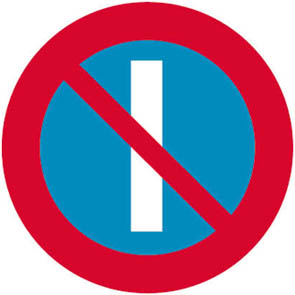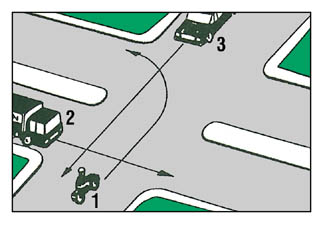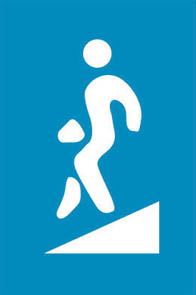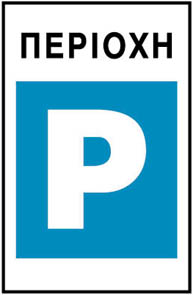Question 1
When should a driver set out on a long journey?
-
Whenever and in whichever condition they are.
-
In morning hours after a normal sleep and rest.
-
After the end of the work so as to gain the time of the following morning.
Question 2
When you meet this traffic sign, are you driving in a priority road?
Question 3
How can fuel consumption be reduced?
-
By ensuring that the tyres of your car have the correct pressure.
-
By having the side window slightly opened during driving.
Question 4
Which vehicle(s) must wait?
-
Vehicle 3 must wait until vehicles 1 and 2 pass.
-
Vehicles 2 and 3 must wait until vehicle 1 passes.
-
Vehicles 1 and 2 must wait until vehicle 3 passes.
Question 5
What is the aim of the mirror in the picture?
-
Indication of a crossroads where priority from the right applies.
-
Timely ascertainment of the movement of vehicles in an oblique or vertical road where there is no visibility.
Question 6
What should the driver be careful about when using the mirrors of a passenger vehicle?
-
The interior mirror gives always full visibility to the right.
-
In a certain area (blind spot) cars that are overtaking may not be visible.
Question 7
Which of these traffic signs means “One-way street”?
-
Traffic sign (B).
-
Traffic sign (A).
Question 8
Does smoking cigarettes inside the vehicle have an effect on driver’s physical state?
Question 9
Driving activity consists of the following:
-
Perception, analysis, decision, action.
-
Decision, perception, analysis, action.
-
Action, perception, analysis, decision.
Question 10
What does this traffic sign mean?
-
Parking is forbidden in odd months on the side where the sign is.
-
Parking of vehicles with an odd plates number is forbidden on the side where the sign is.
-
Parking is forbidden on odd days on the side where the sign is.
Question 11
What should the driver of vehicle 1 do?
-
Give priority to vehicle 2 and then go on, letting vehicle 3 to pass last.
-
Start before vehicle 2 and then stop in the middle of the crossroads giving priority to vehicle 3.
-
Wait for the other two vehicles to pass and then turn.
Question 12
If you compare the steering-wheel with the numbered screen of a clock with hands, the correct position of the driver’s hands when driving straight is at:
-
A quarter past nine to ten past ten.
-
Nine.
-
Five past eleven.
Question 13
The braking distance is:
-
The distance covered by your vehicle from the moment you pressed the footbrake to the moment of its immobilisation.
-
The distance needed for immobilising your vehicle from the moment you saw the obstacle.
Question 14
If the direction indicators of your vehicle do not work, how will you warn of your intention to turn left?
-
By extending your left arm.
-
By raising your left arm vertically.
-
By using the brake lights repeatedly.
Question 15
During driving you realize that you have lost control of the car because there is oil on the road surface. What should you do?
-
Slow down applying the brakes.
-
Release the accelerator pedal and engage a lower gear.
-
Press the accelerator pedal and correct the course through the steering-wheel.
Question 16
When you are moving in a street outside a residential area which is not sufficiently lit, in which cases are you allowed to use the full beam headlights of the vehicle:
-
When a vehicle is ahead at a small distance.
-
When another vehicle is approaching from the opposite direction.
-
When no other vehicle is approaching from the opposite direction and no vehicle is ahead at a small distance.
Question 17
What is the multiplier?
-
A device which distributes high voltage current to the sparking plugs.
-
A device which extinguishes pests.
-
A device which converts the voltage of current from high to low.
Question 18
The consumption of alcohol:
-
Makes you overestimate your actual abilities.
-
Reduces your reaction time.
Question 19
In the event that a fire starts in your vehicle:
-
You should switch off the engine, the people around should move away and you should put out the fire with the help of the fire extinguisher and, if necessary, with sand or earth.
-
You should throw water to the fire.
Question 20
What happens when you are driving with a very low tyre pressure?
-
The tyres may be damaged due to overheating.
-
Driving stability is reduced.
-
Tyres last longer.
Question 21
How can you save fuel and protect the environment, in particular, within a city?
-
By using public transport.
-
By using your car even if public transport can serve your needs.
Question 22
In a state of your obvious drunkenness (over 1,10 grams of alcohol per litre of blood), the Traffic Police:
-
May disqualify you and immobilise your vehicle.
-
May impound your vehicle.
Question 23
What does this traffic sign mean?
-
Parking caravans is forbidden.
-
Mobile repair workshop.
-
Place for caravans.
Question 24
What does this traffic sign mean?
-
Upper (superterrestrial) pedestrian crossing.
-
Lower (underground) pedestrian crossing.
-
Two-level pedestrian crossing without stairs.
Question 25
What does this traffic sign mean?
-
Turn right ahead.
-
Dangerous right bend ahead.
-
Right turn is forbidden.
Question 26
What does this traffic sign mean?
-
Area of permissible parking.
-
Parking is forbidden.
-
Area of limited parking.
Question 27
When does the insurance policy not cover you?
-
If you are responsible for a road accident.
-
If you get involved in a road accident while being drunk.
Question 28
What are the consequences of a significant reduction of the recommended tyre pressure?
-
Environmental pollution is reduced.
-
Fuel consumption and emission of harmful substances are increased.
-
Safer driving.
Question 29
In which cases is horn sounding allowed in cities?
-
Under no circumstances.
-
In cases of emergency for preventing an accident and when you carry persons who are in danger or need medical first aid.
-
When you intend to overtake another vehicle.
Question 30
What may increase fuel consumption?
-
Driving with a new air filter.
-
Driving at the maximum number of revolutions.
-
Driving without unnecessary weight.









